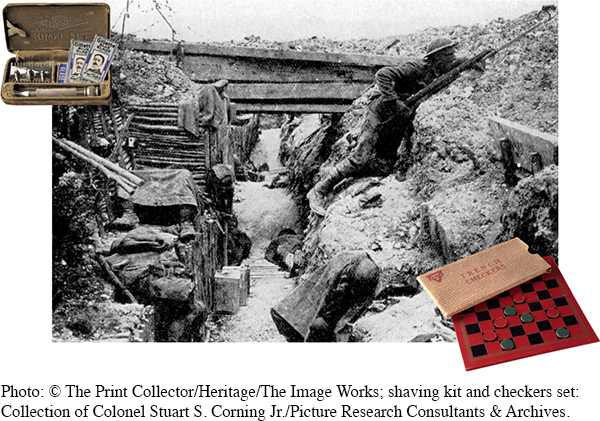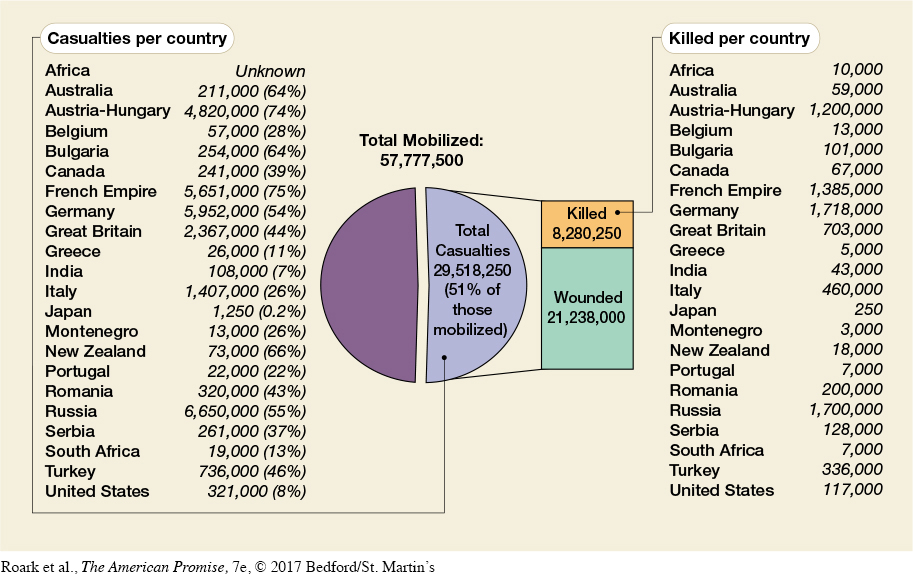The American Promise: Printed Page 625
The American Promise, Value Edition: Printed Page 573
The American Promise: A Concise History: Printed Page 651
Chapter Chronology
The War in France
At the front, the American Expeditionary Force (AEF) discovered a desperate situation. The war had degenerated into a stalemate of armies dug into hundreds of miles of trenches that stretched across France. Huddling in the mud among the corpses and rats, soldiers were separated from the enemy by only a few hundred yards of “no-man’s-land.” When ordered “over the top,” troops raced desperately toward the enemy’s trenches, only to be entangled in barbed wire, enveloped in poison gas, and mowed down by machine guns. The three-day battle of the Somme in 1916 cost the French and British forces 600,000 dead and wounded and the Germans 500,000. The deadliest battle of the war allowed the Allies to advance their trenches only a few meaningless miles.
Still, U.S. troops saw almost no combat in 1917. Troops continued to train and used much of their free time to explore places that most of them could otherwise never hope to see. True to the crusader image, American officials allowed only uplifting tourism. The temptations of Paris were off-limits. French premier Georges Clemenceau’s offer to supply American troops with licensed prostitutes was declined with the half-serious remark that if Wilson found out he would stop the war.

VISUAL ACTIVITYLife in the Trenches One U.S. soldier in a rat-infested trench watches for danger, while three others sit or lie in exhausted sleep. This trench is dry for the moment, but with the rains came mud so deep that wounded men drowned in it. Barbed wire, machine-gun nests, and mortars backed by heavy artillery protected the trenches. Trenches with millions of combatants stretched from French ports on the English Channel all the way to Switzerland. Such holes were miserable, but a decent shave with a Gillette safety razor and a friendly game of checkers offered doughboys temporary relief. Inevitably, however, the whistles would blow, sending the young men rushing toward enemy lines.READING THE IMAGE: What do these images suggest about the reality of life for American soldiers during World War I?CONNECTIONS: How do you suppose the photograph of the trench compares with the doughboys’ expectations of military service in France?
Photo: © The Print Collector/Heritage/The Image Works; shaving kit and checkers set: Collection of Colonel Stuart S. Corning Jr./Picture Research Consultants & Archives.
Sightseeing ended abruptly in March 1918 when a million German soldiers punched a hole in the Allied lines. Pershing finally committed the AEF to combat. In May and June, at Cantigny and then at Château-Thierry, the eager but green Americans checked the German advance with a series of assaults (Map 22.3). Then they headed toward the forest stronghold of Belleau Wood, moving against streams of retreating Allied soldiers who cried defeat: “La guerre est finie!” (The war is over!). A French officer commanded the Americans to retreat with them, but the American commander replied sharply, “Retreat, hell. We just got here.” After charging through a wheat field against withering machine-gun fire, the Marines plunged into hand-to-hand combat. Victory came hard, but a German report praised the enemy’s spirit, noting that “the Americans’ nerves are not yet worn out.” Indeed, it was German morale that was on the verge of cracking.

MAP ACTIVITYMap 22.3 The American Expeditionary Force, 1918 In the last year of the war, the AEF joined the French army on the western front to respond to the final German offensive and pursue the retreating enemy until surrender.READING THE MAP: Across which rivers did the Germans advance in 1918? Where did the armistice line of November 11, 1918, lie in relation to the stabilized front of 1915–1917? Through which countries did the armistice line run?CONNECTIONS: What events paved the way for the AEF to join the combat effort in 1918? What characteristic(s) differentiated American troops from other Allied forces and helped them achieve victory?
The American Promise: Printed Page 625
The American Promise, Value Edition: Printed Page 573
The American Promise: A Concise History: Printed Page 651
Page 627In the summer of 1918, the Allies launched a massive counteroffensive that would end the war. A quarter of a million U.S. troops joined in the rout of German forces along the Marne River. In September, more than a million Americans took part in the assault that threw the Germans back from positions along the Meuse River. In four brutal days, the AEF sustained 45,000 casualties. In November, a revolt against the German government sent Kaiser Wilhelm II fleeing to Holland. On November 11, 1918, a delegation from the newly established German republic met with the French high command to sign an armistice that brought the fighting to an end.
The American Promise: Printed Page 625
The American Promise, Value Edition: Printed Page 573
The American Promise: A Concise History: Printed Page 651
Page 628The adventure of the AEF was brief, bloody, and victorious. When Germany had resumed unrestricted U-boat warfare in 1917, it had been gambling that it could defeat Britain and France before the Americans could raise and train an army and ship it to France. The German military had miscalculated badly. By the end, 112,000 AEF soldiers perished from wounds and disease, while another 230,000 Americans, including George Browne, suffered casualties but survived. Only the Civil War, which lasted much longer, had cost more American lives. European nations, however, suffered much greater losses: 2.2 million Germans, 1.9 million Russians, 1.4 million French, and 900,000 Britons (Figure 22.1). Where they had fought, the landscape was as blasted and barren as the moon.

FIGURE 22.1 Global Comparison: Casualties of the First World War Historians disagree about the number of casualties in World War I. Record keeping in many countries was only rudimentary. Moreover, the destructive nature of the war meant that countless soldiers were wholly obliterated or instantly buried. This chart shows estimates of casualties (the combined number of wounded and killed soldiers) per country. The percentage listed with each casualty figure represents the portion of soldiers mobilized who became casualties. However approximate, these figures make clear that the conflict that raged from 1914 to 1918 was a truly catastrophic world war. Although soldiers came from almost every part of the globe, the human devastation was not evenly distributed. Which country suffered the most casualties? Which country suffered the greatest percentage of casualties? What do you think was the principal reason that the United States suffered a smaller percentage of casualties than most other nations?
REVIEW How did the AEF contribute to the defeat of Germany?


